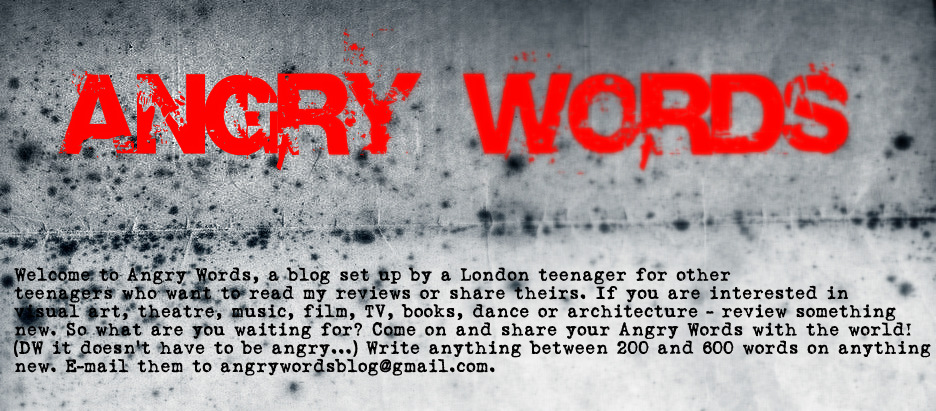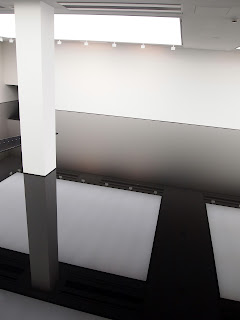The Summer Exhibition 2012 at The Royal Academy
The Royal Academy, located in Picadilly, has showcased Britain's best every year, since 1769. We've seen Emin, Hockney, Gore, Frost and Grimshaw in recent years, a few examples of "The Big Names" that attract thousands of art enthusiasts through the grand entrance every day. At the 2012 exhibition, the billboards inevitably belong to Tracey Emin, famous for arranging beds and embroidering tents with profanities. The way in which the Summer Exhibition works is as follows; every visitor is handed a "List Of Works" as they enter the galleries. This acts as a little catalogue, numbering each work, giving it a sentence of introduction and then showing its price on the side. With prices ranging from £300 to £600,000, very little of the visitors will be buying, but nevertheless, big money will be going to a few artists.
The wonder of the exhibition starts at the beginning. In the courtyard, a sculpture, which could only be described as lengthy, is placed. The sculpture, named "Landscape to Portrait" takes centre stage, stretching thirty metres. It consists of metal rectangles, gradually rotating one by one, to eventually turn from landscape to portrait, hence the name. It certainly wasn't subtle, and unlike most modern art it didn't leave you jaw-dropped, fixated and with a need to inspect it from all angles to find its real meaning. Was it a sign of things to come? Certainly not, but was it a slightly underwhelming heap of metal to plonk in front of one of the most prestigious exhibitions worldwide? Without doubt.
The best aspect of the Summer Exhibition has always been the way it introduced new artists. It was all very well seeing Emin's work there surrounded by a substantial clique of art students all taking photos, but new real talent was unearthed in the small corners of each room. For instance, a head made entirely out of matchsticks, perfect and so subtle. Look at it from a distance, and you think someone's made a head, big deal. One step closer, you see how there are gaps. Maybe it deserves another step, you see it isn't one object, and the last step confirms it. The head is made entirely out of matchsticks and the person who's made it is a complete genius, worthy of all of Emin's praise and maybe a co-lease on a billboard is due. The matchstick head was only one of many, fascinating sculptures, the better of which were not for sale. In another room, the architectural offerings lie. Admittedly, the most outstanding models were not made by artists, but by professional architects. A model of the future London Bridge Station is simply thrilling. Carved out of wood, the train station is so detailed it would be effortless to explore its two square metre plot for hours on end. With five hundred human figures in the train station, each individual figure is unlike any other, and it has a satirical resemblance to a late night London tube stop. You see the late night worker, jacket in hand, suitcase in the other, running for the lift. Whilst doing so, the worker has to fight his way past the drunkard. Bottle in hand, shirt in the other, tottering along, barely avoiding his falling on the tracks. Within hugging distance of the sleazy drunk man, an arguing couple. Woman, bag in hand, the other slapping her husband's cheek. Even though everything was still, it was so easy to imagine the next minute of activity in the station, and all that from a model. That's exactly what you hope to gain from a piece of art. A good few minutes of all angle inspection.
If sculptures aren't your bag, then only a room away are some truly remarkable paintings. One shows a spectacular garden, with hedges intricately trimmed and the grass perfectly level. 'Wow,' you think. Whoever keeps this garden must be really organised. But, then you look at their house. The paint is cracked from the walls, the windows are all broken and the chimney has fallen down. Not complicated, but requires thought. But, like all art galleries, the ridiculous has to be seen, and modern art turns its ugly head. A truly grotesque pink fairy is standing next to a pink something or other. It looks like it was plucked from Disneyland. Then the last room. The crowning jewel of the entire exhibition. But, at the entrance are neon letters, spelling out the word 'DOGS.' They flash viciously in an alarming cyan. And then the end is officially unsatisfactory, the last painting being an Emin. And it is one word scribbled with paint on to canvas, the word being; 'UPSET.' And guess how much it's worth? £165,000. Nevertheless, the Summer Exhibition has succeeded in enlightening all visitors, pointing them to new, innovative talent. And that's what art is about, it's nice seeing famous pieces, Emin's especially, but it is an experience to see the kind of work that is out there. But if one lesson is learned, an entire face made out of matchsticks and the entire story of a late night tube stop is much more stimulating than a pack of static yet irritating, cyan dogs.
The best aspect of the Summer Exhibition has always been the way it introduced new artists. It was all very well seeing Emin's work there surrounded by a substantial clique of art students all taking photos, but new real talent was unearthed in the small corners of each room. For instance, a head made entirely out of matchsticks, perfect and so subtle. Look at it from a distance, and you think someone's made a head, big deal. One step closer, you see how there are gaps. Maybe it deserves another step, you see it isn't one object, and the last step confirms it. The head is made entirely out of matchsticks and the person who's made it is a complete genius, worthy of all of Emin's praise and maybe a co-lease on a billboard is due. The matchstick head was only one of many, fascinating sculptures, the better of which were not for sale. In another room, the architectural offerings lie. Admittedly, the most outstanding models were not made by artists, but by professional architects. A model of the future London Bridge Station is simply thrilling. Carved out of wood, the train station is so detailed it would be effortless to explore its two square metre plot for hours on end. With five hundred human figures in the train station, each individual figure is unlike any other, and it has a satirical resemblance to a late night London tube stop. You see the late night worker, jacket in hand, suitcase in the other, running for the lift. Whilst doing so, the worker has to fight his way past the drunkard. Bottle in hand, shirt in the other, tottering along, barely avoiding his falling on the tracks. Within hugging distance of the sleazy drunk man, an arguing couple. Woman, bag in hand, the other slapping her husband's cheek. Even though everything was still, it was so easy to imagine the next minute of activity in the station, and all that from a model. That's exactly what you hope to gain from a piece of art. A good few minutes of all angle inspection.
If sculptures aren't your bag, then only a room away are some truly remarkable paintings. One shows a spectacular garden, with hedges intricately trimmed and the grass perfectly level. 'Wow,' you think. Whoever keeps this garden must be really organised. But, then you look at their house. The paint is cracked from the walls, the windows are all broken and the chimney has fallen down. Not complicated, but requires thought. But, like all art galleries, the ridiculous has to be seen, and modern art turns its ugly head. A truly grotesque pink fairy is standing next to a pink something or other. It looks like it was plucked from Disneyland. Then the last room. The crowning jewel of the entire exhibition. But, at the entrance are neon letters, spelling out the word 'DOGS.' They flash viciously in an alarming cyan. And then the end is officially unsatisfactory, the last painting being an Emin. And it is one word scribbled with paint on to canvas, the word being; 'UPSET.' And guess how much it's worth? £165,000. Nevertheless, the Summer Exhibition has succeeded in enlightening all visitors, pointing them to new, innovative talent. And that's what art is about, it's nice seeing famous pieces, Emin's especially, but it is an experience to see the kind of work that is out there. But if one lesson is learned, an entire face made out of matchsticks and the entire story of a late night tube stop is much more stimulating than a pack of static yet irritating, cyan dogs.





